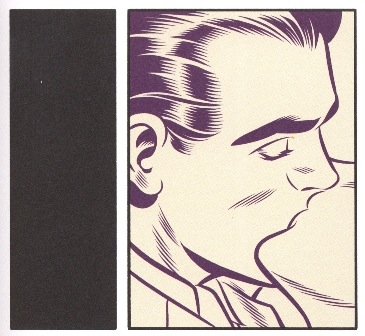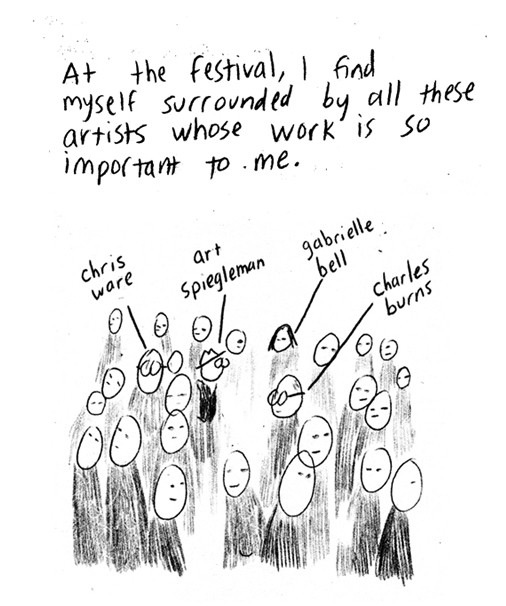§ At TCJ, critic Ken Parille investigates the first two panels of Charles Burns’ THE HIVE in terms of other comics allusions and the flawless internal construct of the book, which he says,
What X’ed Out does for Tintin stories, The Hive does for romance comics, and DC’s 1960s line in particular: it reveals the un-romantic reality these stories conceal.
X’ed OUT and THE HIVE are an amazing multi-leveled story, thought out in every line and packed with as many allusions as a Morrison or Moore comic, and one of the best books currently on sale. Can’t wait for the third volume of the trilogy, although it will probably be a couple of years before it comes out.
§ The suggestion at the Moderate Voice to Let’s Start Celebrating Graphic Novel Tuesday is not entirely serious.
§ Jamie S. Rich reviews Comic Book Confidential: 20th Anniversary Edition :
For fans of comics, a lot of this will be familiar, but whether you’re initiated or not, there is plenty going on in this lean documentary to keep it entertaining. The style is very 1980s, particularly while exploring the early decades, when Mann picks kitschy music from the various periods to enliven his collages and animation. (For some reason, Richard Elfman’s Forbidden Zone kept coming to mind.) The director’s best choice is having the featured creators read from their own work while panels pass by on screen. Hearing Eisner read from The Spirit, or a surprisingly genuine Stan Lee reading Spider-Man, is a real treat. My favorite, though, was Hernandez reading from and sketching addendums to an early Maggie and Hopey story from Love & Rockets. The 1950s illustration style of Charles Burns’ Big Baby also lends itself really well to the animated style Mann uses, which is largely just shifting around the art that already exists. Turns out this “motion comics” malarkey publishers have tried to sell us as being innovative for the last couple of years is just as outdated as we always thought.
§ Taschen is re-releasing the immense $200 history of DC comics by Paul Levitz as FIVE smaller, cheaper volumes, but each will contain, even more art, and new interviews Levitz tells CBR:
Taschen has some unique publishing strategies that they’ve exercised before with large art books, and this relates to some of the approaches they’ve taken historically. What they’re doing is they’re splitting the book into the five different eras that we used as our breakpoints in the history of DC, but each of the different volumes gets about fifty percent more art. They found so much wonderful artwork, so in one sense each volume is certainly physically much smaller than the original, but each one is also much richer. There’s not a lot of edits on the written side; the main thing that we added in each volume, besides a little bit of updating and clean-up, is an original interview, which was a lot of fun to conduct for each. We got one of the last interviews with Joe Kubert for the Golden Age, and then to talk to Denny O’Neil and Neal Adams and Jenette Khan and Jim Lee about their different eras. That was a great deal of fun because these were all people who are good friends and hopefully I was able to get some interesting different direction out of them. But the amount of extra art that’s being added is just phenomenal — we found, for instance with Kubert, one of his early sample pieces, and that’s archeology as much as anything else!
§ Sequart’s Julian Darius offers his own perspective on the Battle of the Magicians while examining the use of influence, borrowing, and homage in both Moore and Morrison.
Whether Moore knew Superfolks, or to what extent, is important to document if we can. Pádraig Ó Méalóid has done comics a service in looking at this. We may well be writing academic dissertations on the subject for centuries. But the two works are completely different beasts, and this would be the case even if the superficial similarities were striking — and they’re not. Hypothetically, even if every single element of Marvelman could be tracked back to one satirical super-hero piece or another, this still wouldn’t constitute theft by any meaningful definition of the term. To remix and fuse all those elements into a whole with a new tone of stark realism would itself be original. And it’s this tone, more than any single element or idea, that was Marvelman‘s great innovation. Just to be fair, consider The Matrix, which Morrison has alleged was borrowed heavily from The Invisibles. There, the similarities are much clearer — especially with Morrison’s fashion-obsessed killer King Mob and the action-oriented Invisibles, Volume Two. But The Invisibles isn’t a Hollywood action flick in tone. King Mob is balanced by a team of different personalities, whose very different histories and viewpoints are explored. In The Invisibles, all the heroes are King Mobs. Even the cool-looking, fashion-obsessed element works very differently: King Mob and Neo might both wear shades indoors, but King Mob wears many outfits and stands out, whereas all the heroes of The Matrix were the same outfits, thus representing a cooler-looking form of conformity.
§ A new episode of the podcast Webcomics Weekly is up.
§ UK publisher Kenny Penman of Black Slate has his thoughts on Thought Bubble and comics’ recent surge in respectability.
The awards are a mark of the new confidence of British comics creators who are increasingly producing graphic novels for an growing number of UK-based publishers, rather than exporting their talent abroad.
We have all seen square-spine comics invading bookshop shelves, be it the avalanche of Manga titles or comics with a more literary bent such as Chris Ware’s Jimmy Corrigan or Alison Bechdel’s Fun Home, both published by Cape.
§ This piece entitled Five Titles to Get a Dude into Comics may not be entirely serious.
§ This piece from July by Dr. Nerdlove on “Fake” Geek Girls predates the current hoohah but sums up many things:
The “fake” geek girl is the nerd equivalent of the welfare queen – a semi-mythical beast who somehow ruins things for everybody by… well, nobody’s entirely sure. Confusing their poor sad boners, evidently. Nobody has ever been able to explain to my satisfaction just how this hurts geek culture. Somebody dressing up in a sexy costume because being ogled makes them feel good doesn’t affect me or my friends’ participation in geek culture in any meaningful way. Putting the blame on these fake geek attention grabbers for narrowly defining the role of women in geekdom only serves to absolve the men who act as gatekeepers, insisting that the only role open to women is to be a sexual object rather than a full partner – while denigrating them for doing so at the exact same time.
§ BCGF was so protean that I am still finding things I meant to link to, like Hallie Bateman’s lovely comic strip.
§ This headline about a UK grandma who has Stuff Person Syndrome who claims it makes her ‘I swell up like the Incredible Hulk’ may not be entirely serious.






Thanks for posting a link to my essay!
I love reading Kibbles-n-Bits, and I am being entirely serious.
“UK publisher Kenny Penman of Black Slate…”
Shouldn’t that be “*Blank* Slate”?
Thanks for all the news coverage, as always.
“Whether Moore knew Superfolks, or to what extent, is important” …”We may well be writing academic dissertations on the subject for centuries.”
Actually, in centuries to come academic dissertations will focus on whether or not Alan Moore even existed, or if Grant Morrison actually wrote all those comics under the Alan Moore pseudonym, or if a third party , Earl Edward de Vere using time travel technology, jumped from era to era writing all Homer, all Shakespeare, all Moore & Morrison, having read them in the far-flung future in the first place.
Comments are closed.